Relationship between Tibetan Plateau Surface Heat Fluxes and Daily Heavy Precipitation in the Middle and Lower Yangtze River Basins (1980–2022)
Abstract
1. Introduction
2. Study Regions and Data Acquisition
3. Methodologies
3.1. Screening for the LSDHPEs in the MLYR
3.2. Classification of Synoptic Patterns
3.3. Identifying the Lagged Correlation between Heat Fluxes and Precipitation
4. Results
4.1. Features of Precipitation and LSDHPEs in the MLYR

4.2. Typical Synoptic Pattern of LSDHPEs in the MLYR
4.3. Time-Lagged Effect of TP Anomalous Surface Heat Flux on LSDHPEs
5. Discussion
6. Conclusions
Author Contributions
Funding
Data Availability Statement
Acknowledgments
Conflicts of Interest
Appendix A
Appendix A.1. Precision Validation of Three Precipitation Datasets

Appendix A.2. Accuracy Comparison of SOM Classification with Different Number of Nodes
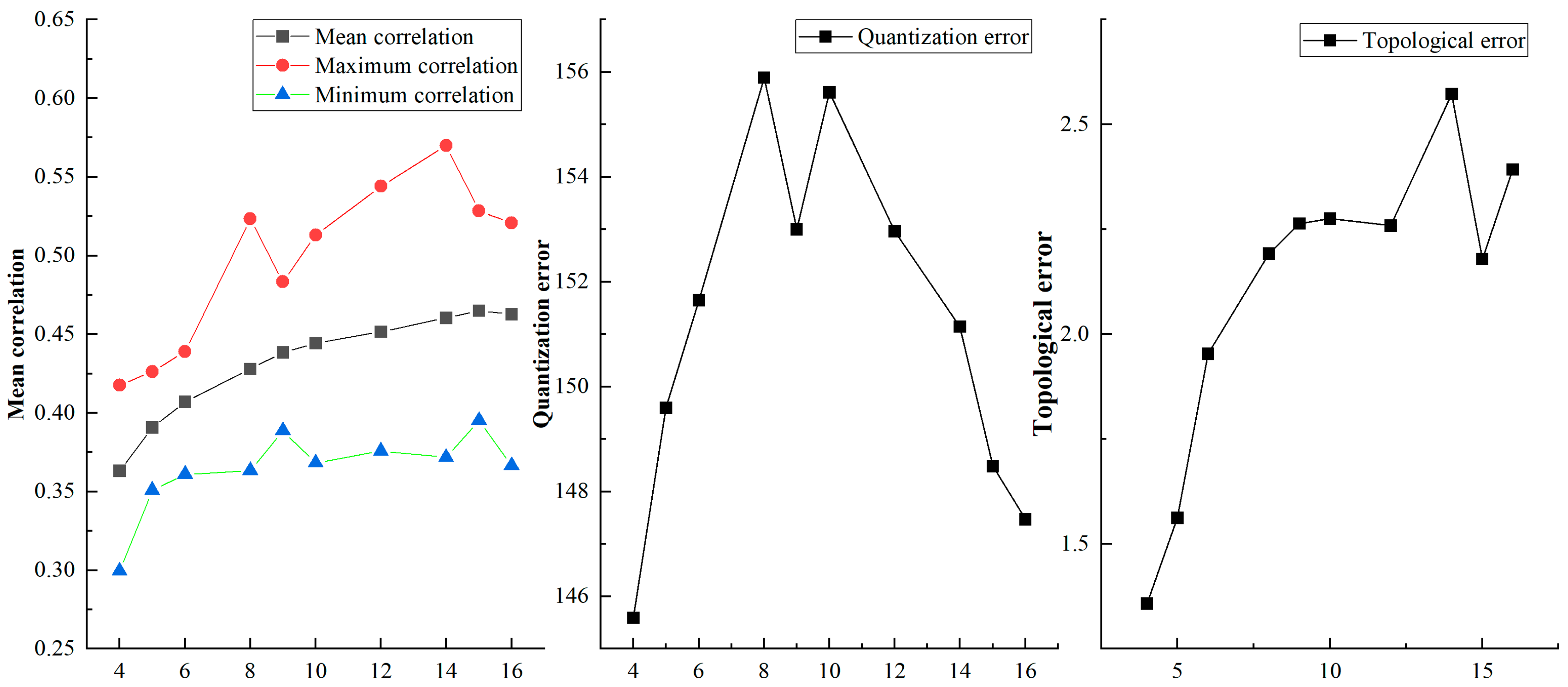


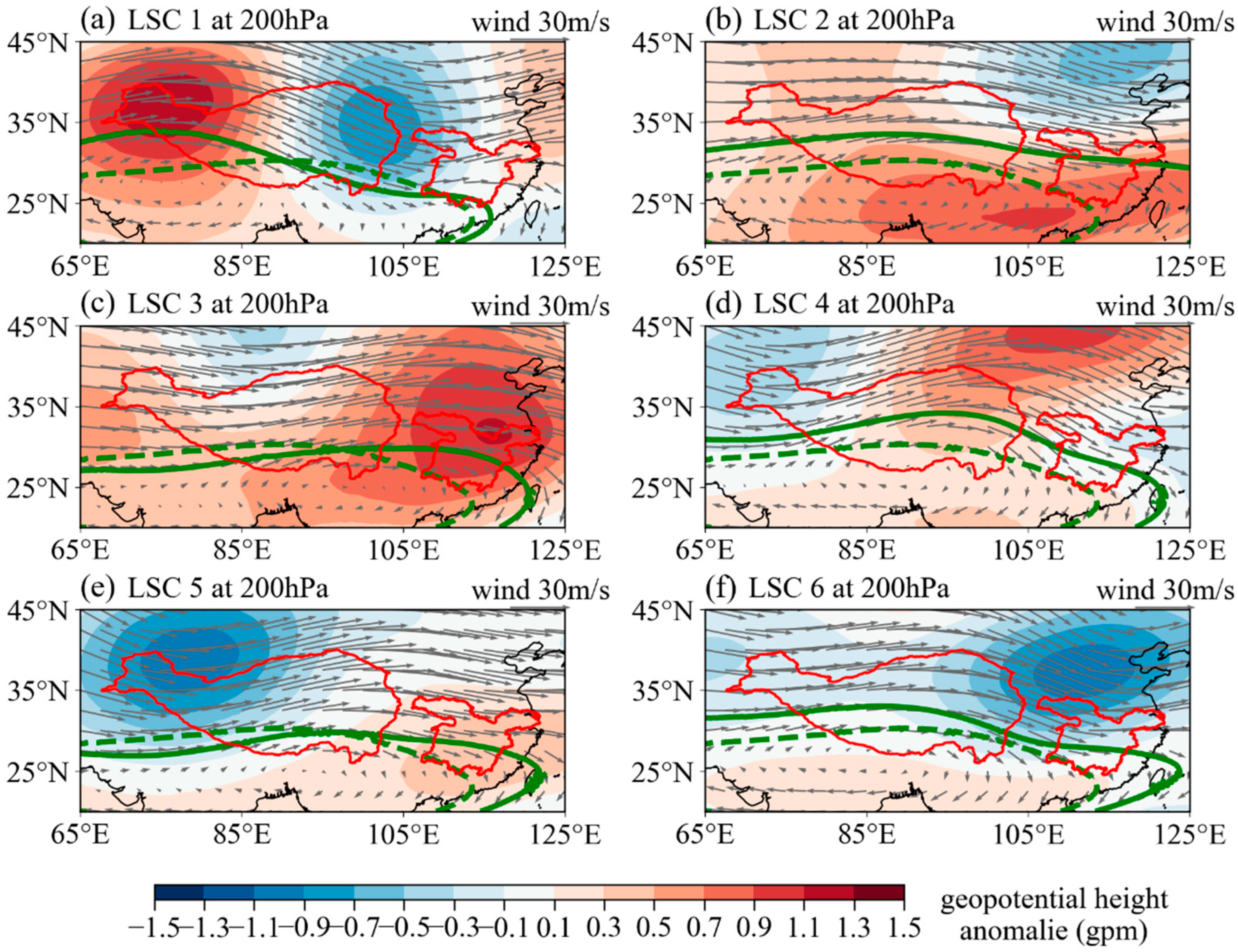
Appendix A.3. Lagged Correlation Coefficient Curves in Various Locations and SOM Modes
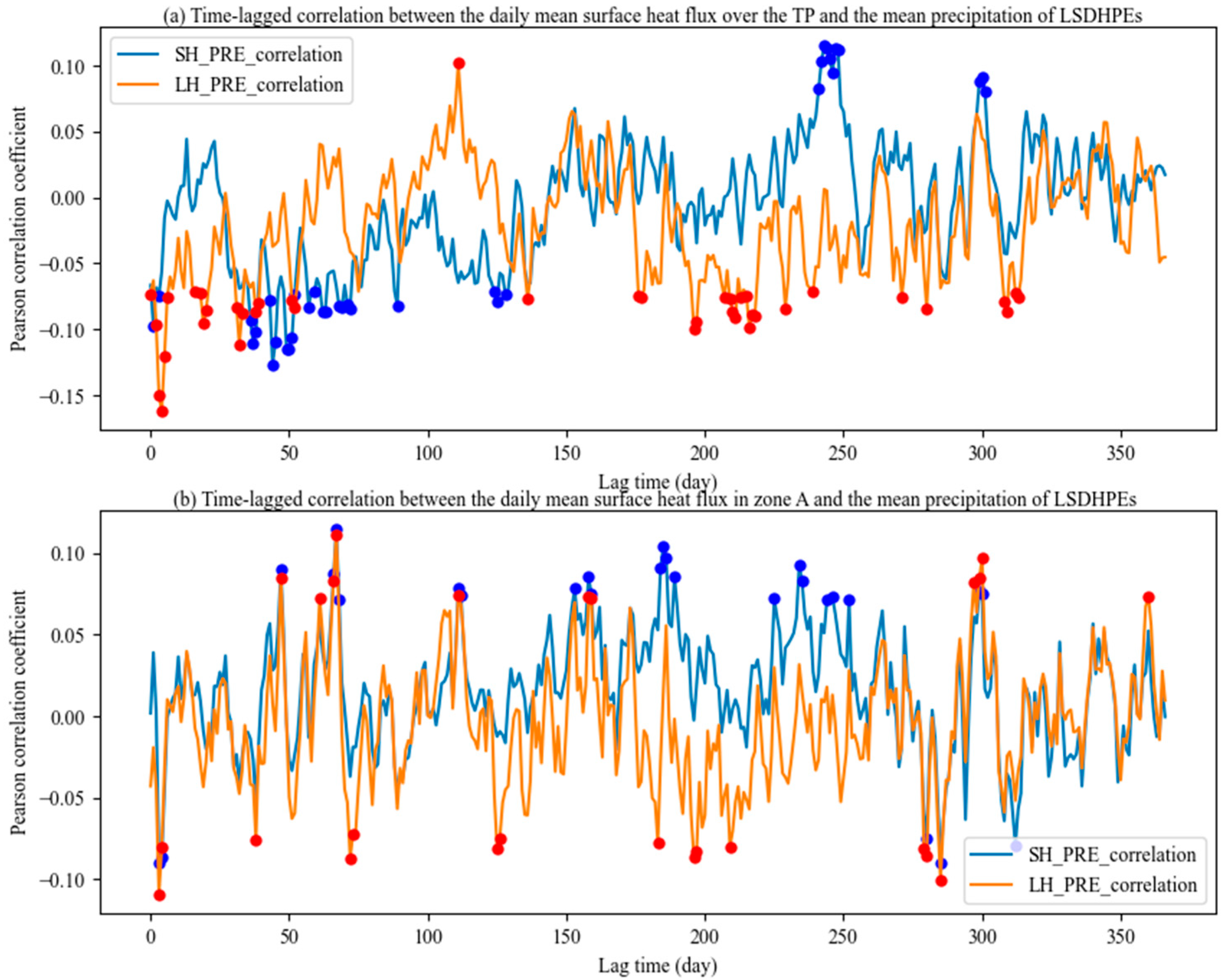
References
- Huang, J.; Zhou, X.; Wu, G.; Xu, X.; Zhao, Q. Global Climate Impacts of Land-Surface and Atmospheric Processes over the Tibetan Plateau. Rev. Geophys. 2023, 61, e2022RG000771. [Google Scholar] [CrossRef]
- Yao, T.; Thompson, L.G.; Mosbrugger, V.; Zhang, F.; Ma, Y.; Luo, T.; Xu, B.; Yang, X.; Joswiak, D.R.; Wang, W.; et al. Third Pole Environment (TPE). Environ. Dev. 2012, 3, 52–64. [Google Scholar] [CrossRef]
- Dong, W.; Lin, Y.; Wright, J.S.; Ming, Y.; Xie, Y.; Wang, B.; Luo, Y.; Huang, W.; Huang, J.; Wang, L.; et al. Summer rainfall over the southwestern Tibetan Plateau controlled by deep convection over the Indian subcontinent. Nat. Commun. 2016, 7, 10925. [Google Scholar] [CrossRef] [PubMed]
- Xu, X.; Zhao, T.; Lu, C.; Guo, Y.; Chen, B.; Liu, R.; Li, Y.; Shi, X. An important mechanism sustaining the atmospheric “water tower” over the Tibetan Plateau. Atmos. Chem. Phys. 2014, 14, 11287–11295. [Google Scholar] [CrossRef]
- Ye, Y.; Tian, R.; Jin, Z. Dynamic Effects of Atmosphere over and around the Tibetan Plateau on the Sustained Drought in Southwest China from 2009 to 2014. Remote Sens. 2023, 15, 2198. [Google Scholar] [CrossRef]
- Han, Y.; Jiang, D.; Si, D.; Ma, Y.; Ma, W. Time-lagged Effects of the Spring Atmospheric Heat Source over the Tibetan Plateau on Summer Precipitation in Northeast China during 1961–2020: Role of Soil Moisture. Adv. Atmos. Sci. 2024, 41, 1527–1538. [Google Scholar] [CrossRef]
- Xu, H.; Liang, X.-Z.; Xue, Y. Regional climate modeling to understand Tibetan heating remote impacts on East China precipitation. Clim. Dyn. 2022, 62, 2683–2701. [Google Scholar] [CrossRef]
- Zhao, Y.; Chen, D.; Deng, Y.; Son, S.-W.; Wang, X. How Were the Eastward-Moving Heavy Rainfall Events from the Tibetan Plateau to the Lower Reaches of the Yangtze River Enhanced? J. Clim. 2021, 34, 607–620. [Google Scholar] [CrossRef]
- Chen, Y.; Zhang, A.; Wang, B.; Fu, Y. A Heavy Precipitation Event in the Yangtze River Basin Led by an Eastward Moving Tibetan Plateau Cloud System in the Summer of 2016. J. Geophys. Res.-Atmos. 2020, 125, e2020JD032429. [Google Scholar] [CrossRef]
- Dong, L.; Xu, X.; Zhao, T.; Ren, H. Linkage between moisture transport over the Yangtze River Basin and a critical area of the Tibetan Plateau during the Meiyu. Clim. Dyn. 2019, 53, 2643–2662. [Google Scholar] [CrossRef]
- Xu, C.; Yuan, C.; Li, X.; Lin, Y.; Fan, H. Projection of disaster-causing risk of extreme precipitation in the Yangtze River Basin based on CMIP6. Hydrol. Res. 2023, 54, 401–407. [Google Scholar] [CrossRef]
- Sun, S.; Zhao, Y.; He, Y.; Xia, Z.; Chen, S.; Zhang, Y.; Sun, Q. Exacerbated climate risks induced by precipitation extremes in the Yangtze River basin under warming scenarios. Front. Ecol. Evol. 2023, 11, 1127875. [Google Scholar] [CrossRef]
- Bi, Y.; Zheng, L.; Wang, Y.; Li, J.; Yang, H. Coupling relationship between urbanization and water-related ecosystem services in China’s Yangtze River economic Belt and its socio-ecological driving forces: A county-level perspective. Ecol. Indic. 2023, 146, 109871. [Google Scholar] [CrossRef]
- Wang, Y.; Xu, Y.; Tabari, H.; Wang, J.; Wang, Q.; Song, S.; Hue, Z. Innovative trend analysis of annual and seasonal rainfall in the Yangtze River Delta, eastern China. Atmos. Res. 2020, 231, 104673. [Google Scholar] [CrossRef]
- Xu, X.; Lu, C.; Ding, Y.; Shi, X.; Guo, Y.; Zhu, W. What is the relationship between China summer precipitation and the change of apparent heat source over the Tibetan Plateau? Atmos. Sci. Lett. 2013, 14, 227–234. [Google Scholar] [CrossRef]
- Ge, J.; Youa, Q.; Zhang, Y. Effect of Tibetan Plateau heating on summer extreme precipitation in eastern China. Atmos. Res. 2019, 218, 364–371. [Google Scholar] [CrossRef]
- Wang, Z.; Duan, A.; Wu, G. Time-lagged impact of spring sensible heat over the Tibetan Plateau on the summer rainfall anomaly in East China: Case studies using the WRF model. Clim. Dyn. 2014, 42, 2885–2898. [Google Scholar] [CrossRef]
- Li, X.; Zhang, K.; Gu, P.; Feng, H.; Yin, Y.; Chen, W.; Cheng, B. Changes in precipitation extremes in the Yangtze River Basin during 1960–2019 and the association with global warming, ENSO, and local effects. Sci. Total Environ. 2021, 760, 144244. [Google Scholar] [CrossRef]
- Zhang, Q.; Xu, C.-Y.; Zhang, Z.; Chen, Y.D.; Chun-ling Liu, H.L. Spatial and temporal variability of precipitation maxima during 1960-2005 in the Yangtze River basin and possible association with large-scale circulation. J. Hydrol. 2008, 353, 215–227. [Google Scholar] [CrossRef]
- Xie, Y.; Huang, J.; Wu, G.; Liu, Y.; Dong, W.; Lu, M. Oceanic repeaters boost the global climatic impact of the Tibetan Plateau. Sci. Bull. 2023, 68, 2225–2235. [Google Scholar] [CrossRef]
- Kuang, X.; Jiao, J.J. Review on climate change on the Tibetan Plateau during the last half century. J. Geophys. Res. Atmos. 2016, 121, 3979–4007. [Google Scholar] [CrossRef]
- Yang, H.; Deng, Y.; Cui, C.; Wang, X.; Dong, X. Dynamic Trigger and Moisture Source of Two Typical Meiyu Front Rainstorms Associated with Eastward-Moving Cloud Clusters from the Tibetan Plateau. J. Meteorol. Res. 2022, 36, 478–499. [Google Scholar] [CrossRef]
- Wang, M.; Wang, J.; Duan, A.; Yang, J.; Liu, Y. Quasi-biweekly impact of the atmospheric heat source over the Tibetan Plateau on summer rainfall in Eastern China. Clim. Dyn. 2019, 53, 4489–4504. [Google Scholar] [CrossRef]
- Li, J.; Chen, Y.; Mao, J.; Zhai, P. Increase in optimal configuration of 25–60-day atmospheric circulations for Yangtze heavy rainfall under global warming background. Weather. Clim. Extrem. 2023, 42, 100630. [Google Scholar] [CrossRef]
- Xu, X.; Lu, C.; Shi, X.; Gao, S. World water tower: An atmospheric perspective. Geophys. Res. Lett. 2008, 35, L20815. [Google Scholar] [CrossRef]
- Su, Z.; Ma, Y.; Chen, X.; Dong, X.; Du, J.; Han, C.; He, Y.; Hofste, J.G.; Li, M.; Li, M.; et al. Monitoring Water and Energy Cycles at Climate Scale in the Third Pole Environment (CLIMATE-TPE). Remote Sens. 2021, 13, 3661. [Google Scholar] [CrossRef]
- Zhao, Y.; Xu, X.; Ruan, Z.; Chen, B.; Wang, F. Precursory strong-signal characteristics of the convective clouds of the Central Tibetan Plateau detected by radar echoes with respect to the evolutionary processes of an eastward-moving heavy rainstorm belt in the Yangtze River Basin. Meteorol. Atmos. Phys. 2019, 131, 697–712. [Google Scholar] [CrossRef]
- Zhao, Y.; Sun, R.; Xie, Z.; Duan, A. Upper-Troposphere Saddle-Like Response to Springtime Surface Sensible Heating Over the Tibetan Plateau: Combined Effect From Baroclinic and Barotropic Process. J. Geophys. Res.-Atmos. 2022, 127, e2021JD036002. [Google Scholar] [CrossRef]
- Zeng, J.; Huang, A.; Wu, P.; Huang, D.; Zhang, Y.; Tang, J.; Zhao, D.; Yang, B.; Chen, S. Typical Synoptic Patterns Responsible for Summer Regional Hourly Extreme Precipitation Events Over the Middle and Lower Yangtze River Basin, China. Geophys. Res. Lett. 2023, 50, e2023GL104829. [Google Scholar] [CrossRef]
- Chen, J.; Li, Y.; Xiong, B.; Wang, Y.; Zhou, S.; Huang, Y. Comparison of Moisture Sources of Summer Precipitation in 1998 and 2020 in the Middle and Lower Reaches of Yangtze River Basin. Int. J. Climatol. 2023, 43, 3493–3505. [Google Scholar] [CrossRef]
- Zhu, C.; Ullah, W.; Wang, G.; Lu, J.; Li, S. Diagnosing Potential Impacts of Tibetan Plateau Spring Soil Moisture Anomalies on Summer Precipitation and Floods in the Yangtze River Basin. J. Geophys. Res. Atmos. 2023, 128, e2022JD037671. [Google Scholar] [CrossRef]
- Wu, D.; Zhang, F.; Wang, C. Impacts of Diabatic Heating on the Genesis and Development of an Inner Tibetan Plateau Vortex. J. Geophys. Res.-Atmos. 2018, 123, 11691–11704. [Google Scholar] [CrossRef]
- Ma, J.; Wei, K.; Chen, W.; Wang, T.; Shi, D. The southward movement preference of large-scale persistent extreme precipitation events over the Yangtze River Valley during Mei-yu period. Clim. Dyn. 2023, 60, 3729–3747. [Google Scholar] [CrossRef]
- Tao, S.; Ding, Y. Observational Evidence of the Influence of the Qinghai-Xizang (Tibet) Plateau on the Occurrence of Heavy Rain and Severe Convective Storms in China. Bull. Am. Meteorol. Soc. 1981, 62, 23–30. Available online: https://www.jstor.org/stable/26221519 (accessed on 20 August 2024). [CrossRef]
- Zhan, C.; Shi, Q.; Liang, S. Assessing the impacts of the spring sensible heat flux over the Tibetan Plateau on Asian summer monsoon rainfall using observational and reanalysis data. Int. J. Climatol. 2019, 40, 2342–2358. [Google Scholar] [CrossRef]
- Wan, B.; Gao, Z.; Chen, F.; Lu, C. Impact of Tibetan Plateau Surface Heating on Persistent Extreme Precipitation Events in Southeastern China. Mon. Weather. Rev. 2017, 145, 3485–3505. [Google Scholar] [CrossRef]
- Sun, Y.; Shan, X.; Zhou, S.; Wang, M.; Wang, C.; Deng, Z. Impacts of Tibetan Plateau sensible heat and El Nino-Southern Oscillation on precipitation over South China under the background of the PDO. Front. Environ. Sci. 2023, 11, 1156206. [Google Scholar] [CrossRef]
- Huang, W.; Zhao, Y.; Sun, C.; Wang, H.; Wang, X. Climate modulation of summer rainstorm activity in eastern China based on the Tibetan Plateau spring heating. Arab. J. Geosci. 2020, 13, 126. [Google Scholar] [CrossRef]
- Yang, K.; Qi, Q.; Wang, C. Possible impacts of vegetation cover increment on the relationship between winter snow cover anomalies over the Third Pole and summer precipitation in East Asia. NPJ Clim. Atmos. Sci. 2023, 6, 140. [Google Scholar] [CrossRef]
- Qi, W.; He, L.; Hai, J.; Wei, W. Relationship between spring soil moisture in the Tibetan Plateau and summer precipitation in the Yangtze river basin and its possible mechanism. Chin. J. Geophys.-Chin. Ed. 2016, 59, 3985–3995. [Google Scholar] [CrossRef]
- Zhang, C.; Jia, X.; Wen, Z. Increased impact of the Tibetan Plateau Spring Snow Cover to the Meiyu Rainfall over the Yangtze River Valley after 1990s. J. Clim. 2021, 34, 5985–5997. [Google Scholar] [CrossRef]
- Xu, Y.; Gao, X.; Shen, Y.; Xu, C.; Shi, Y.; Giorgi, F. A Daily Temperature Dataset over China and Its Application in Validating a RCM Simulation. Adv. Atmos. Sci. 2009, 26, 763–772. [Google Scholar] [CrossRef]
- Xu, X.; Huang, A.; Huang, D.; Gu, C. What Are the Dominant Synoptic Patterns Leading to the Summer Regional Hourly Extreme Precipitation Events Over Central-Eastern Tibetan Plateau and Sichuan Basin. Geophys. Res. Lett. 2023, 50, e2022GL102342. [Google Scholar] [CrossRef]
- Kohonen, T. Self-organized formation of topologically correct feature maps. Biol. Cybern. 1982, 43, 59–69. [Google Scholar] [CrossRef]
- Ng, C.P.; Zhang, Q.; Li, W. Changes in Hourly Extreme Precipitation Over Eastern China From 1970 to 2019 Dominated by Synoptic-Scale Precipitation. Geophys. Res. Lett. 2021, 48, e2020GL090620. [Google Scholar] [CrossRef]
- Shin, Y.; Kim, J.-H.; Chun, H.-Y.; Jang, W.; Son, S.-W. Classification of Synoptic Patterns With Mesoscale Mechanisms for Downslope Windstorms in Korea Using a Self-Organizing Map. J. Geophys. Res. Atmos. 2022, 127, e2021JD035867. [Google Scholar] [CrossRef]
- Loikith, P.C.; Lintner, B.R.; Sweeney, A. Characterizing Large-Scale Meteorological Patterns and Associated Temperature and Precipitation Extremes over the Northwestern United States Using Self-Organizing Maps. J. Clim. 2017, 30, 2829–2847. [Google Scholar] [CrossRef]
- Lee, S.; Feldstein, S.B. Detecting Ozone- and Greenhouse Gas–Driven Wind Trends with Observational Data. Science 2013, 339, 563–567. [Google Scholar] [CrossRef]
- Horton, D.E.; Johnson, N.C.; Singh, D.; Swain, D.L.; Rajaratnam, B.; Diffenbaugh, N.S. Contribution of changes in atmospheric circulation patterns to extreme temperature trends. Nature 2015, 522, 465–469. [Google Scholar] [CrossRef]
- Cohen, J.; Coumou, D.; Screen, J.A.; Furtado, J.C.; Barlow, M.; Francis, J.; Dethloff, K.; Whittleston, D. Recent Arctic amplification and extreme mid-latitude weather. Nat. Geosci. 2014, 7, 627–637. [Google Scholar] [CrossRef]
- Cassano, J.J.; Uotila, P.; Lynch, A.H.; Cassano, E.N. Predicted changes in synoptic forcing of net precipitation in large Arctic river basins during the 21st century. J. Geophys. Res. 2007, 112, G04S49. [Google Scholar] [CrossRef]
- Gong, H.; Wang, L.; Zhou, W.; Chen, W.; Wu, R.; Liu, L. Revisiting the Northern Mode of East Asian Winter Monsoon Variation and Its Response to Global Warming. J. Clim. 2018, 31, 9001–9014. [Google Scholar] [CrossRef]
- Chen, Y.; Wang, A.; Feng, G. The relative contribution of large-scale circulation and local soil moisture to summer precipitation over Asian mid-low latitudes. Clim. Dyn. 2022, 60, 2097–2112. [Google Scholar] [CrossRef]
- Lin, R.; Zhu, J.; Zheng, F. The Application of the SVD Method to Reduce Coupled Model Biases in Seasonal Predictions of Rainfall. J. Geophys. Res.-Atmos. 2019, 124, 11837–11849. [Google Scholar] [CrossRef]
- Wallace, J.M.; Smith, C.; Bretherton, C.S. Singular Value Decomposition of Wintertime Sea Surface Temperature and 500-mb Height Anomalies. J. Clim. 1992, 5, 561–576. [Google Scholar] [CrossRef]
- Zhong, L.; MA, Y.; Salama, M.S.; Su, Z. Assessment of vegetation dynamics and their response to variations in precipitation and temperature in the Tibetan Plateau. Clim. Chang. 2010, 103, 519–535. [Google Scholar] [CrossRef]
- Roerink, G.J.; Menenti, M.; Verhoef, W. Reconstructing cloudfree NDVI composites using Fourier analysis of time series. Int. J. Remote Sens. 2000, 21, 1911–1917. [Google Scholar] [CrossRef]
- Sun, Q.; Miao, C.; Duan, Q.; Sorooshian, S.; Hsu, K.-L. A Review of Global Precipitation Data Sets: Data Sources, Estimation, and Intercomparisons. Rev. Geophys. 2017, 56, 79–107. [Google Scholar] [CrossRef]
- Chen, B.; Xu, X.-D.; Zhao, T. Main moisture sources affecting lower Yangtze River Basin in boreal summers during 2004–2009. Int. J. Climatol. 2012, 33, 1035–1046. [Google Scholar] [CrossRef]
- Xia, Y.; Yao, S.; Sun, T.; Guo, Z. Role of the Low-Latitude Quasi-Biweekly Oscillation in the Extreme Persistent Heavy Rainfall in the Mei-Yu Season over the Middle and Lower Reaches of the Yangtze River. J. Clim. 2023, 36, 3817–3832. [Google Scholar] [CrossRef]
- Zhang, J.; Zhao, K.; Wang, Y.; Kong, X.; Shao, X.; Liang, Y. Modulation of centennial-scale hydroclimate variations in the middle Yangtze River Valley by the East Asian-Pacific pattern and ENSO over the past two millennia. Earth Planet. Sci. Lett. 2021, 576, 117220. [Google Scholar] [CrossRef]
- Xiao, M.; Zhang, Q.; Singh, V.P. Influences of ENSO, NAO, IOD and PDO on seasonal precipitation regimes in the Yangtze River basin, China. Int. J. Climatol. 2015, 35, 3385–3720. [Google Scholar] [CrossRef]
- Deng, M.; Meng, X.; Sheng, D.; Niu, H.; Wu, P.; Li, Z.; Zhao, L.; Chen, H. Observed surface heat fluxes partitioning during the local growing season over the Tibetan Plateau. Agric. For. Meteorol. 2024, 356, 110186. [Google Scholar] [CrossRef]
- Dong, Y.; Li, G.; Xie, X.; Yang, L.; Zhang, P.; Zeng, B. Mechanism of Diabatic Heating on Precipitation and the Track of a Tibetan Plateau Vortex over the Eastern Slope of the Tibetan Plateau. Adv. Atmos. Sci. 2024, 41, 155–172. [Google Scholar] [CrossRef]
- Li, L.; Zhang, R.; Wen, M.; Duan, J. Development and eastward movement mechanisms of the Tibetan Plateau vortices moving off the Tibetan Plateau. Clim. Dyn. 2019, 52, 4849–4859. [Google Scholar] [CrossRef]
- Xu, H.; Zhao, D.; Yin, J.; Duan, Y.; Gao, W.; Li, Y.; Zhou, L. Indirect Effects of Binary Typhoons on an Extreme Rainfall Event in Henan Province, China From 19 to 21 July 2021. 3. Sensitivities to Microphysics Schemes. J. Geophys. Res.-Atmos. 2023, 128, e2022JD037936. [Google Scholar] [CrossRef]
- Wu, G.; Liu, Y.; He, B.; Bao, Q.; Duan, A.; Jin, F.-F. Thermal Controls on the Asian Summer Monsoon. Sci. Rep. 2012, 2, 404. [Google Scholar] [CrossRef]
- Hu, L.; Deng, D.; Gao, S.; Xu, X. The seasonal variation of Tibetan Convective Systems: Satellite observation. J. Geophys. Res. Atmos. 2016, 121, 5512–5525. [Google Scholar] [CrossRef]
- Xu, X.D.; Shi, X.Y.; Wang, Y.Q.; Peng, S.Q.; Shi, X.H. Data analysis and numerical simulation of moisture source and transport associated with summer precipitation in the Yangtze River Valley over China. Meteorol. Atmos. Phys. 2008, 100, 217–231. [Google Scholar] [CrossRef]
- Zhao, Y.; Xu, X.; Liu, L.; Zhang, R. Effects of convection over the Tibetan Plateau on rainstorms downstream of the Yangtze River Basin. Atmos. Res. 2019, 219, 24–35. [Google Scholar] [CrossRef]
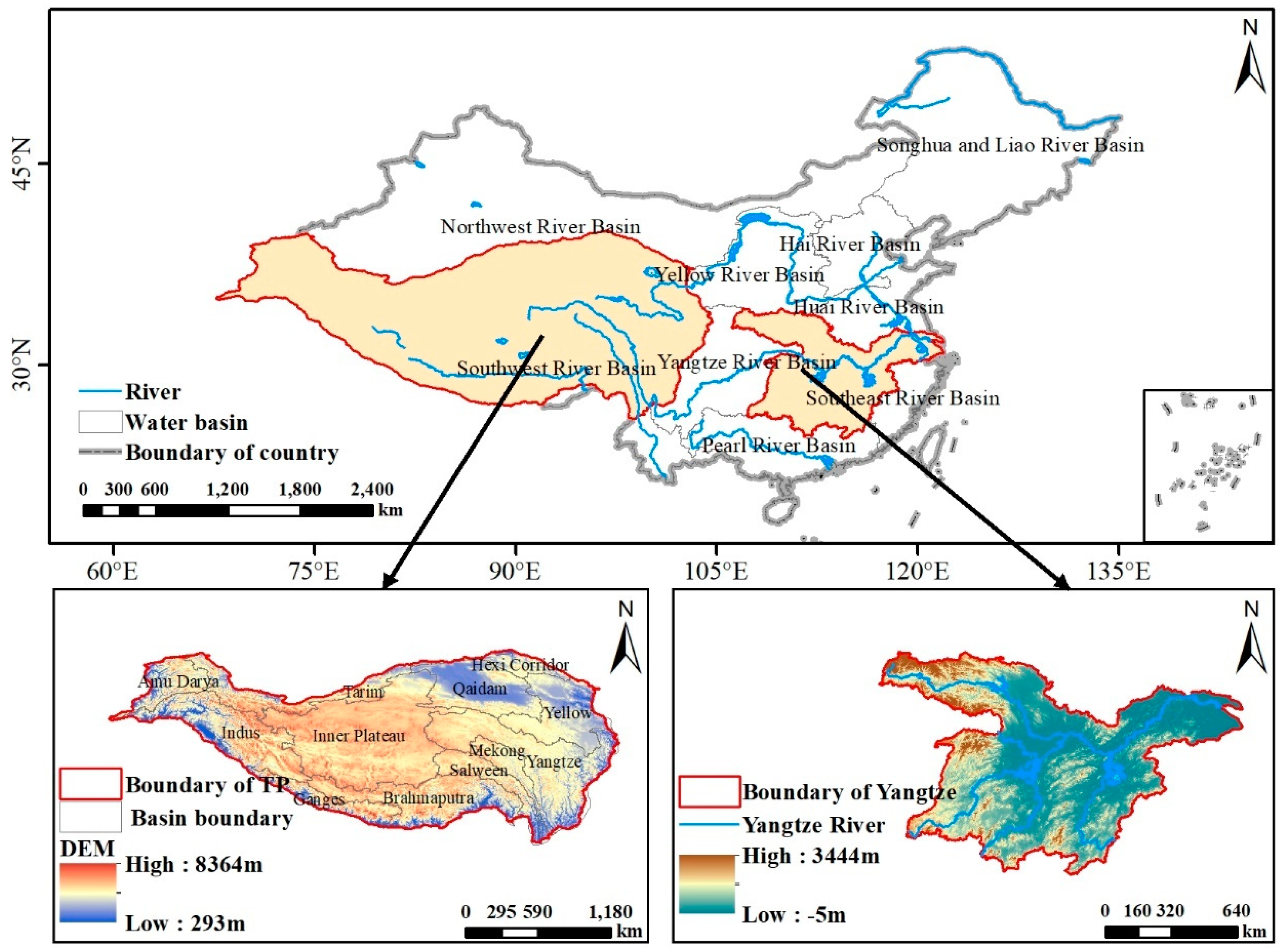
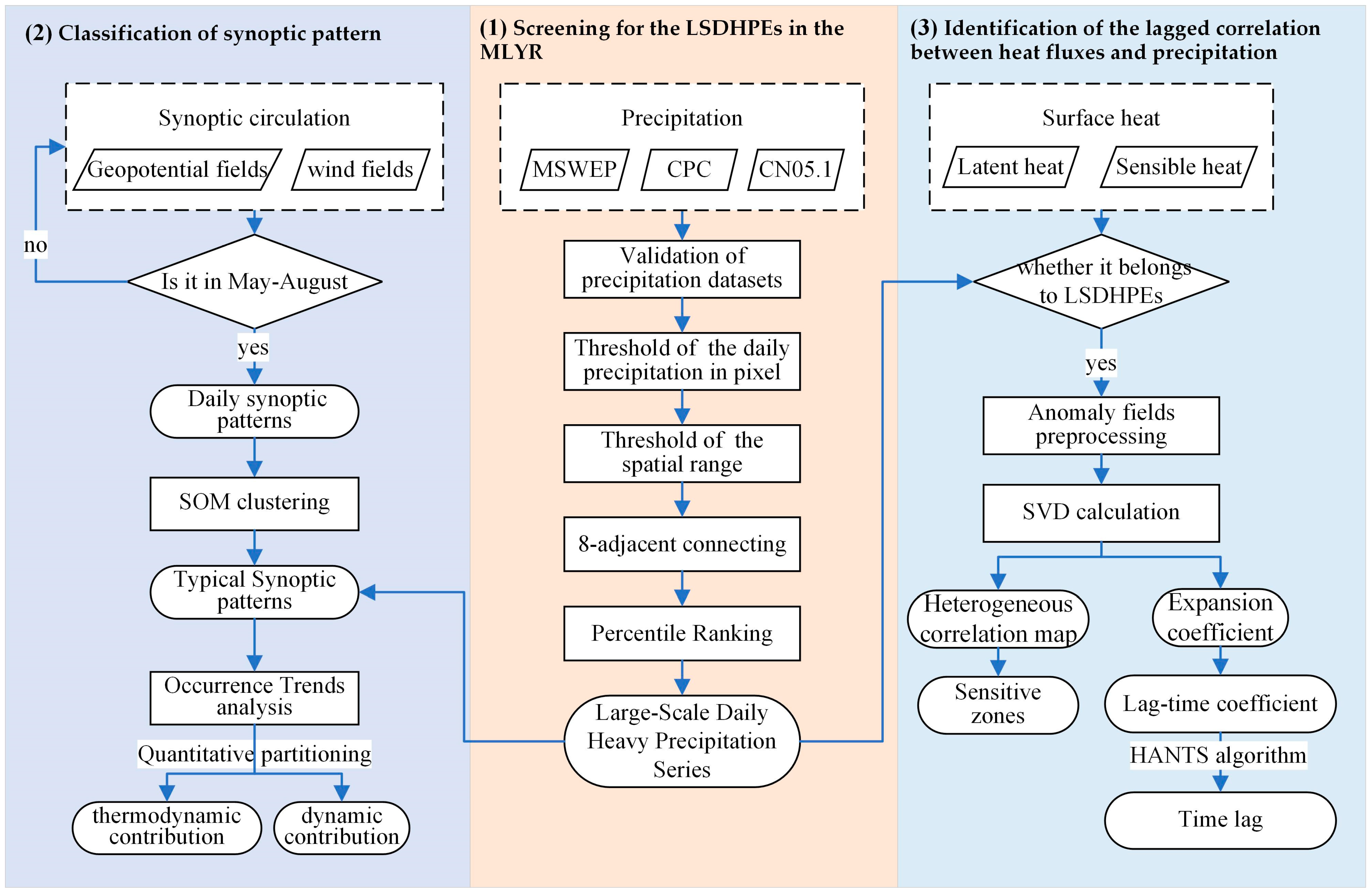

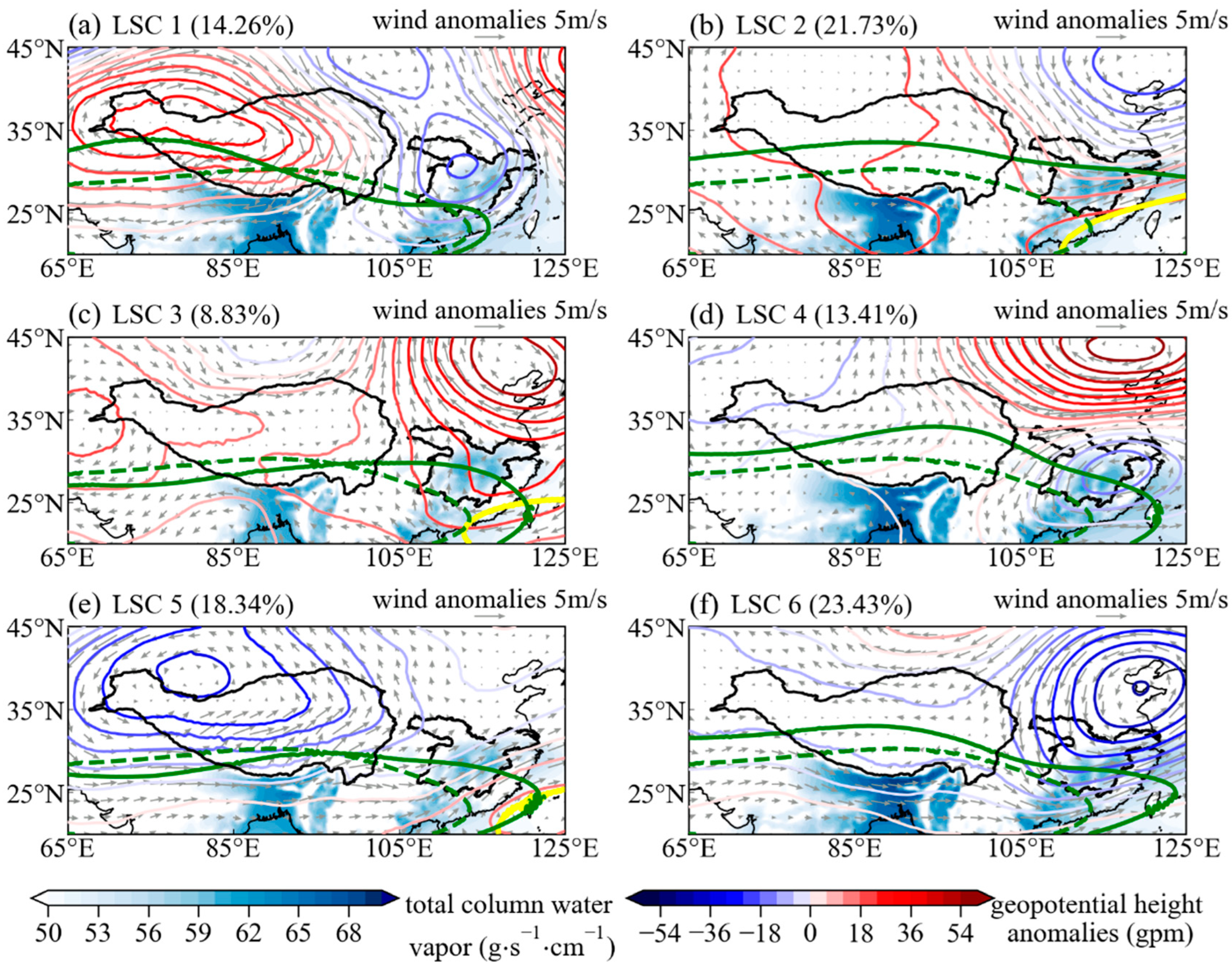

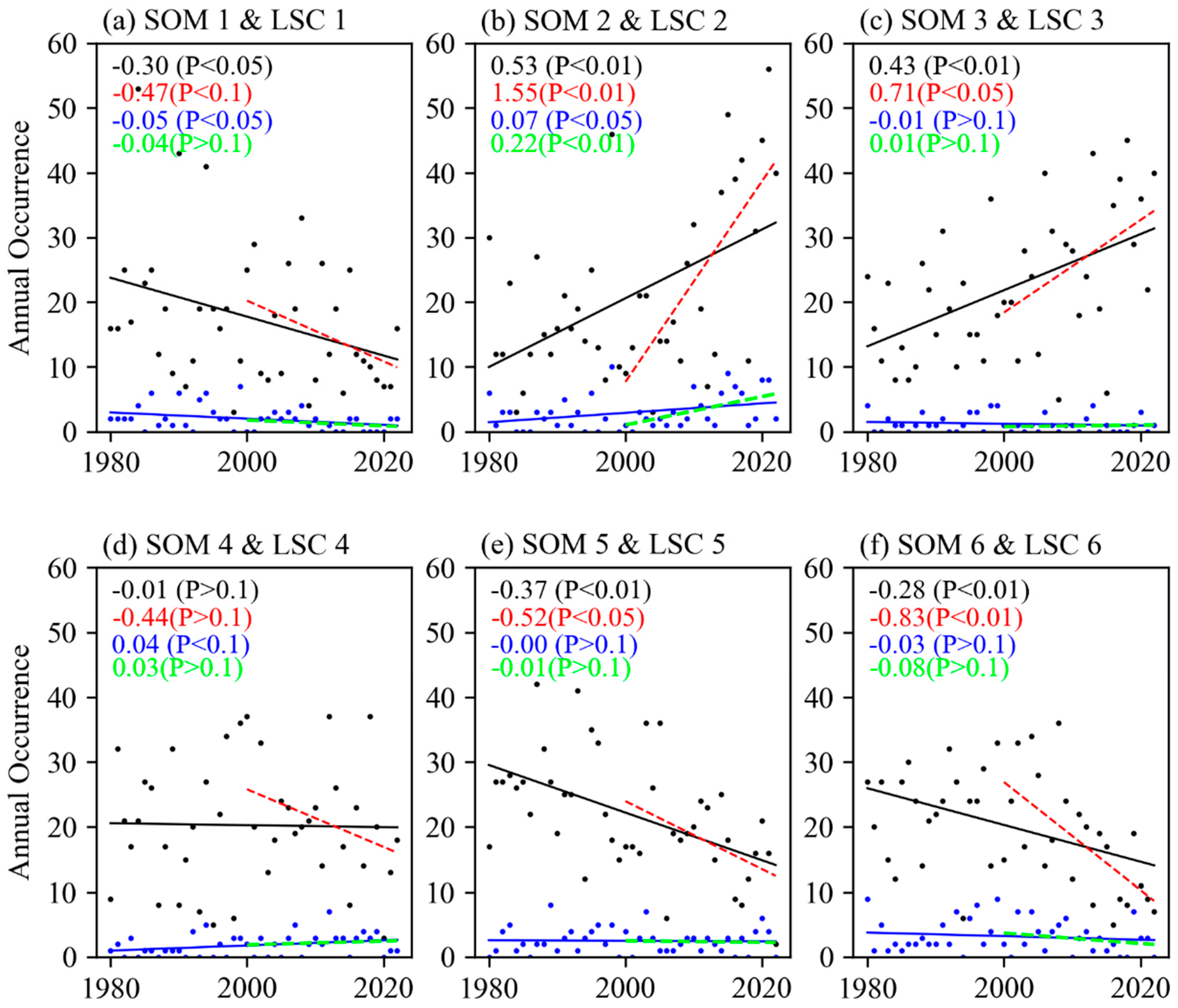
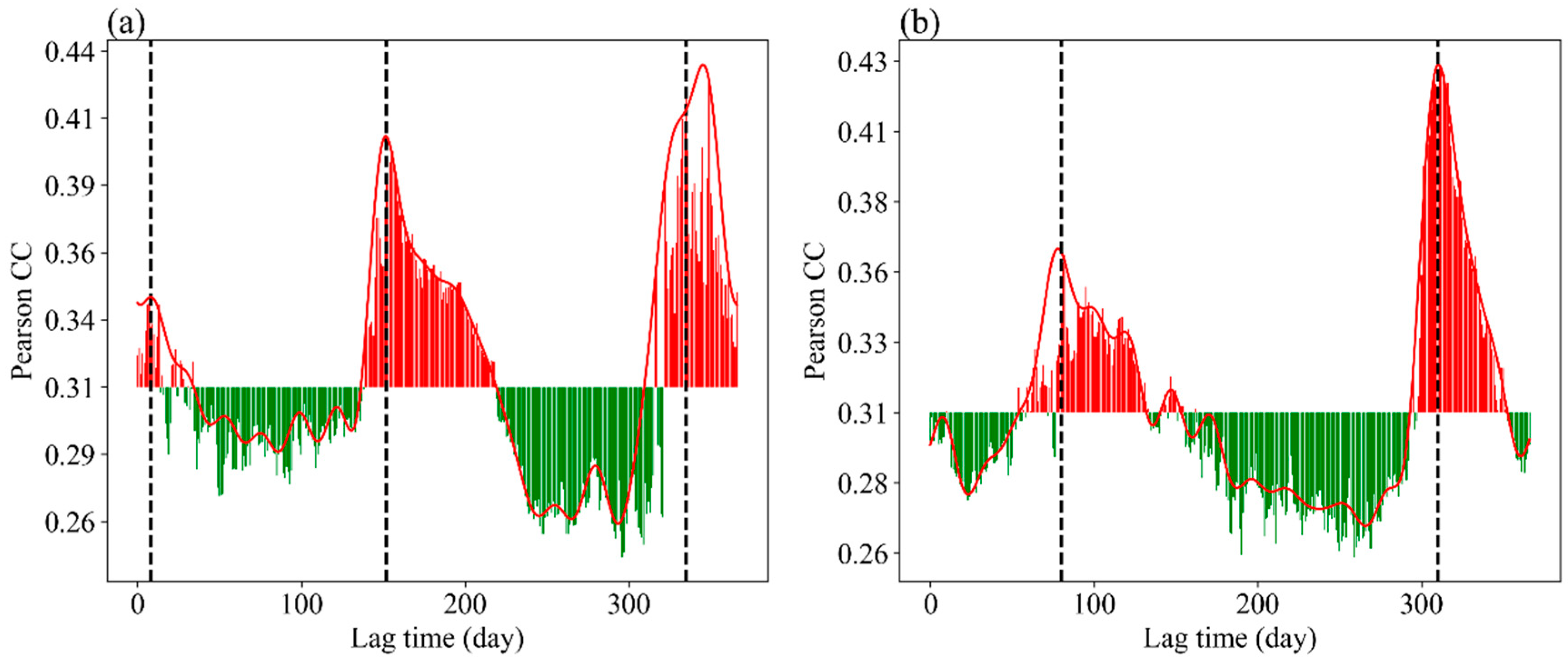

| Items | SOM 1 | SOM 2 | SOM 3 | SOM 4 | SOM 5 | SOM 6 | Total |
|---|---|---|---|---|---|---|---|
| Trend in the thermodynamic influence | −0.006 | 0.010 | −0.002 | 0.005 | −0.001 | −0.004 | 0.004 |
| Trend in the dynamic influences | −0.004 | 0.010 | 0.003 | 0.000 | −0.006 | −0.006 | −0.002 |
| Trend in the interaction influences | −0.002 | 0.007 | −0.001 | 0.001 | 0.001 | 0.002 | 0.009 |
| Total trend | −0.012 | 0.028 | 0.001 | 0.007 | −0.006 | −0.008 | 0.011 |
| Percent of total trend | −109.59 | 266.63 | 7.59 | 62.36 | −53.74 | −73.24 | |
| Percent of thermodynamic | 48.24 | 36.34 | −245.07 | 80.75 | 9.64 | 47.47 | |
| Percent of dynamic | 33.66 | 37.27 | 433.84 | −2.74 | 107.67 | 77.83 | |
| Percent of the interaction | 18.11 | 26.40 | −88.77 | 21.99 | −17.31 | −25.30 |
Disclaimer/Publisher’s Note: The statements, opinions and data contained in all publications are solely those of the individual author(s) and contributor(s) and not of MDPI and/or the editor(s). MDPI and/or the editor(s) disclaim responsibility for any injury to people or property resulting from any ideas, methods, instructions or products referred to in the content. |
© 2024 by the authors. Licensee MDPI, Basel, Switzerland. This article is an open access article distributed under the terms and conditions of the Creative Commons Attribution (CC BY) license (https://creativecommons.org/licenses/by/4.0/).
Share and Cite
Li, L.; Dong, X.; Ma, Y.; Jin, H.; Wei, C.; Su, B. Relationship between Tibetan Plateau Surface Heat Fluxes and Daily Heavy Precipitation in the Middle and Lower Yangtze River Basins (1980–2022). Remote Sens. 2024, 16, 3779. https://doi.org/10.3390/rs16203779
Li L, Dong X, Ma Y, Jin H, Wei C, Su B. Relationship between Tibetan Plateau Surface Heat Fluxes and Daily Heavy Precipitation in the Middle and Lower Yangtze River Basins (1980–2022). Remote Sensing. 2024; 16(20):3779. https://doi.org/10.3390/rs16203779
Chicago/Turabian StyleLi, Lu, Xiaohua Dong, Yaoming Ma, Hanyu Jin, Chong Wei, and Bob Su. 2024. "Relationship between Tibetan Plateau Surface Heat Fluxes and Daily Heavy Precipitation in the Middle and Lower Yangtze River Basins (1980–2022)" Remote Sensing 16, no. 20: 3779. https://doi.org/10.3390/rs16203779
APA StyleLi, L., Dong, X., Ma, Y., Jin, H., Wei, C., & Su, B. (2024). Relationship between Tibetan Plateau Surface Heat Fluxes and Daily Heavy Precipitation in the Middle and Lower Yangtze River Basins (1980–2022). Remote Sensing, 16(20), 3779. https://doi.org/10.3390/rs16203779








